Disassembly Investigation of Batteries and Capacitors,
Investigation for Deterioration and Defect,
and Structural Analysis
Investigation of Causes of Deterioration & Failure of Batteries and Capacitors
JFE Techno-Research (JFE-TEC) investigates the causes of trouble and failure such as poor performance, swelling, fire, etc. in batteries, capacitors, and other energy devices with a wide range of sizes, from large-scale automotive cells to mobile phone batteries.
JFE-TEC can also investigate the cause and mechanism of battery deterioration by examination of battery parts after long-term deterioration tests.
In addition to investigation of battery parts by disassembling cells, we also assess the state of deterioration and study its cause by nondestructive investigation of the internal structure by X-ray fluoroscopy and X-ray CT.
It is also possible to investigate the location of internal short circuits and contamination by foreign matters by analysis of the condition of heat generation by infrared camera.
Causes of Deterioration & Failure of Lithium-Ion Batteries
-
Deterioration of lithium-ion battery
Phenomena in which the internal resistance of a battery increases, charging capacity decreases, etc.
[Main causes of deterioration]
- Formation of film on electrode surface (results in: increased internal resistance,decreased electrode adhesion)
- Delamination of electrode (results in: impossible charging at delaminated parts)
- Decreased migration of Li ions (results in: deposition of metallic Li, etc. on electrode surface)
-
Failure of lithium-ion batteries
Phenomena including deterioration of performance, swelling of the cell, leakage of the electrolyte, smoke, fire, etc. immediately after start of use
[Main causes of deterioration]
- Leakage of moisture into electrolyte or residual moisture due to inadequate drying of electrode
Li + H2O → LiOH + 1/2H2 - Formation of HF (hydrofluoric acid) by reaction of residual moisture and electrolyte
LiPF6 → PF5 + LiF PF5 + H2O → PF3O + 2HF - Heat generation/fire due to internal short circuit caused by contamination by foreign matters or improper cell assembly
- Leakage of moisture into electrolyte or residual moisture due to inadequate drying of electrode
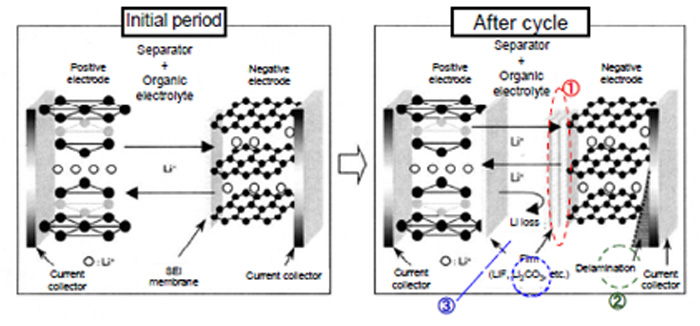
Examples of Investigation of Causes of Deterioration/Failure of Li-Ion Battery
Example of Investigation of Deterioration of Mobile Phone Li-Ion Battery after Long-term Use
-
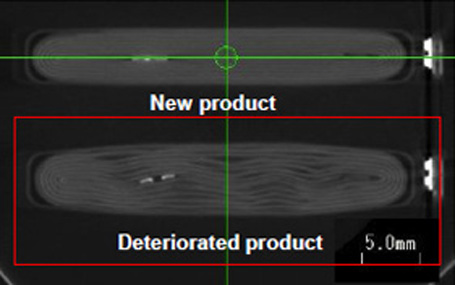
Images showing X-ray CT observation of
interior of deteriorated batteryPosition of internal swelling was identified by X-ray CT. -
Disassembly of
deteriorated battery -
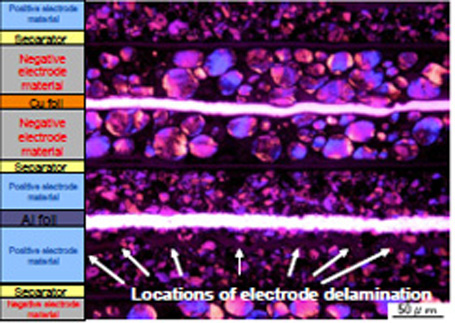
Polarizing microscope image of cross
section of deteriorated batteryVoids have formed due to
delamination of the active material
of the positive electrode.
Example of Investigation of Cause of Swelling of Mobile Phone Lithium Ion Battery Immediately after Start of Use
-
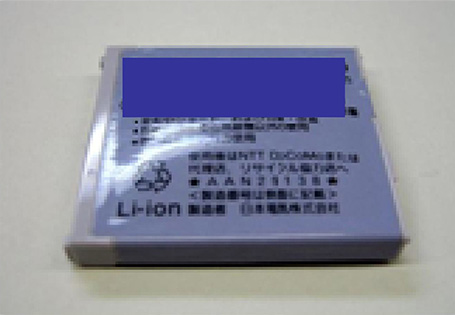
Appearance of swollen battery -
Sampling of
gas in battery
Gas analysis
(GC, GC-MS) -
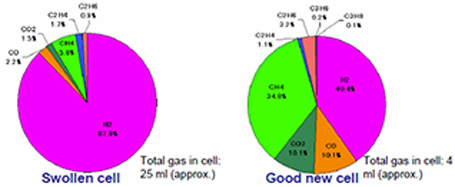
Sampling of gas in battery → Gas analysis
Total amount of gas in the swollen cell was about 6 times that in a good new cell, and most of the gas was hydrogen.
Contamination of cell by water and/or overcharging was presumed to be the cause of swollenness of cell.
Analysis methods for component materials of batteries and capacitors
| Material | Purpose | Method | |
|---|---|---|---|
| Electrode |
Electrode/active material (incl. conductive aid) |
Identification of crystal structure and components of electrode | X-ray diffraction |
| Elemental composition analysis | ICP | ||
| Cross-section structure analysis | FIB, cross-section Ar milling | ||
| Surface state analysis | XPS | ||
|
Negative electrode/active material (incl. conductive aid) |
Graphite content of graphite negative electrode Crystalline orientation, crystal size |
X-ray diffraction | |
| Cross-section structure analysis | FIB-SEM, CP-SEM | ||
| Surface state analysis | XPS | ||
| Binder | Analysis of components of binder and thickener | FT-IR Thermal decomposition- GC-MS |
|
| Tab lead | Ultrasonic welding state investigation | Cross sectional SEM | |
| Separator | Components | Microscopic FT-IR | |
| Layer composition | SEM, microscopic Raman | ||
| Electrolyte solution |
Solvent | Moisture content analysis of main component, impurity and modified product |
GC, GC-MS Karl Fischer method |
| Electrolyte | Component analysis | LC-MS, ICP | |
| Additive | Component analysis | FT-IR, GC-MS | |
| Cladding | |||


